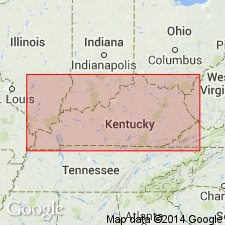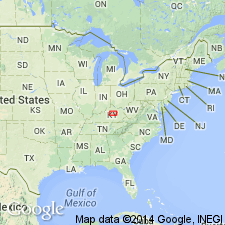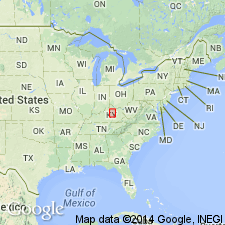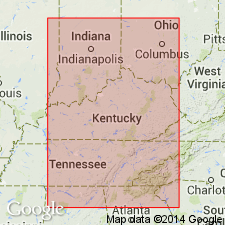
- Usage in publication:
-
- Millersburg member
- Modifications:
-
- Named
- Dominant lithology:
-
- Limestone
- Shale
- AAPG geologic province:
-
- Cincinnati arch
Summary:
Named as a member of Cynthiana formation. Type locality is the vicinity of Millersburg, Bourbon Co., KY. Composed of richly fossiliferous, argillaceous, irregularly bedded limestones, frequently weathering into irregular fragments called rubble. Was previously included in the Greendale member of Cynthiana formation.
Source: GNU records (USGS DDS-6; Reston GNULEX).

- Usage in publication:
-
- Millersburg Member*
- Modifications:
-
- Principal reference
- Revised
- AAPG geologic province:
-
- Cincinnati arch
Summary:
Designated Millersburg Member of Lexington Limestone. Consists of nodular, irregularly-bedded limestone and shale with a profusion of fossils. Ranges in thickness up to 10 ft or more. Reference section established.
Source: GNU records (USGS DDS-6; Reston GNULEX).

- Usage in publication:
-
- Millersburg Member*
- Modifications:
-
- Overview
- AAPG geologic province:
-
- Cincinnati arch
Summary:
Used as Millersburg Member of Lexington Limestone. Complexly intertongues with Tanglewood Limestone Member of Lexington Limestone and with lower part of Clays Ferry Formation. Also overlies Devils Hollow Member of Lexington.
Source: GNU records (USGS DDS-6; Reston GNULEX).

- Usage in publication:
-
- Millersburg Member*
- Modifications:
-
- Overview
- AAPG geologic province:
-
- Cincinnati arch
Summary:
The Millersburg Member of the Lexington Limestone consists of gray to brownish gray, nodular- and irregularly bedded, fossiliferous limestone and shale. Shale makes up about one-third of the unit. Thickness is 0 to 90 feet. Overlies the Devils Hollow Member of the Lexington and the Tanglewood Limestone Member, which it also intertongues with, and underlies and intertongues with the Clays Ferry Formation. The environment of deposition is interpreted to be shallow, moderately agitated, normal marine.
Source: GNU records (USGS DDS-6; Reston GNULEX).

- Usage in publication:
-
- Millersburg Member*
- Modifications:
-
- Age modified
- AAPG geologic province:
-
- Cincinnati arch
Summary:
Figure 3 indicates that Millersburg Member of Lexington Limestone is Champlainian (Shermanian), but boundary between Shermanian and Edenian Stages (also the top of the Millersburg) is queried.
Source: GNU records (USGS DDS-6; Reston GNULEX).
For more information, please contact Nancy Stamm, Geologic Names Committee Secretary.
Asterisk (*) indicates published by U.S. Geological Survey authors.
"No current usage" (†) implies that a name has been abandoned or has fallen into disuse. Former usage and, if known, replacement name given in parentheses ( ).
Slash (/) indicates name conflicts with nomenclatural guidelines (CSN, 1933; ACSN, 1961, 1970; NACSN, 1983, 2005, 2021). May be explained within brackets ([ ]).

